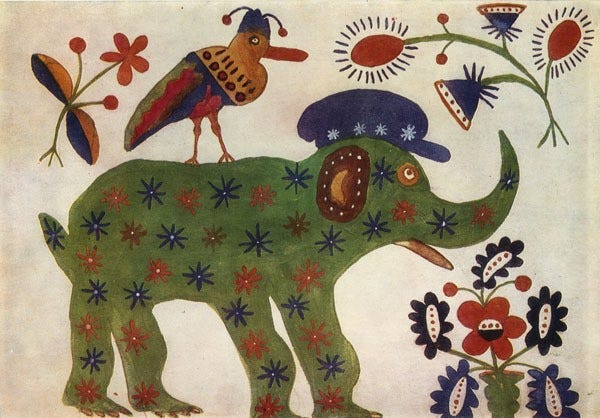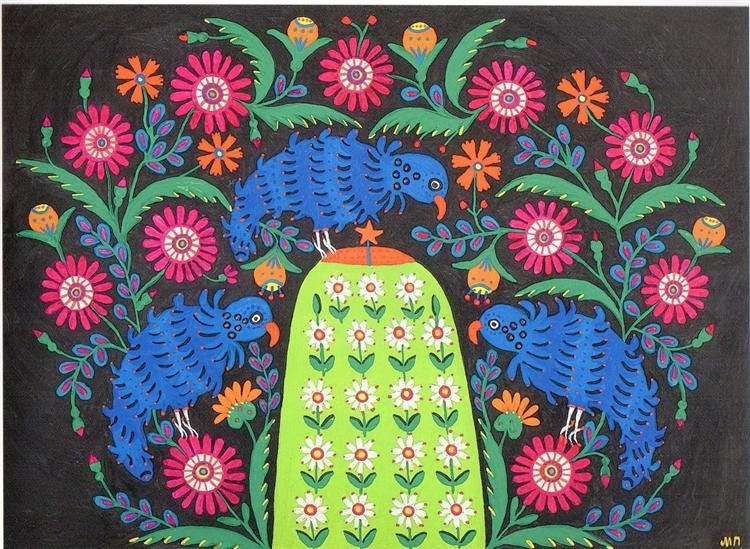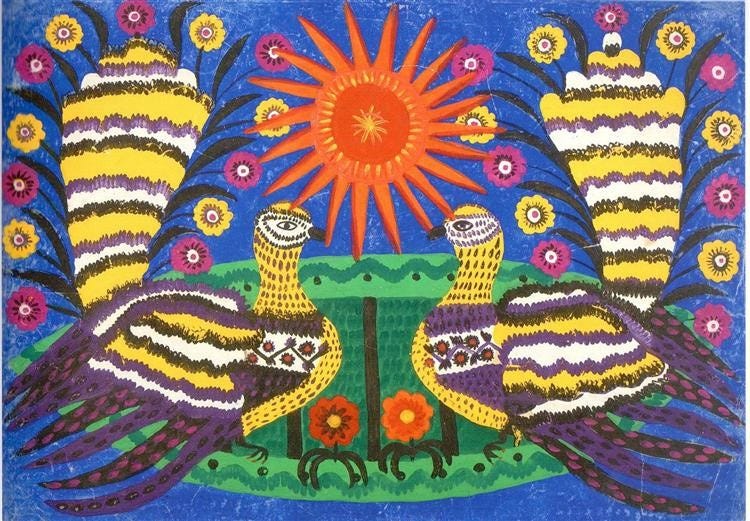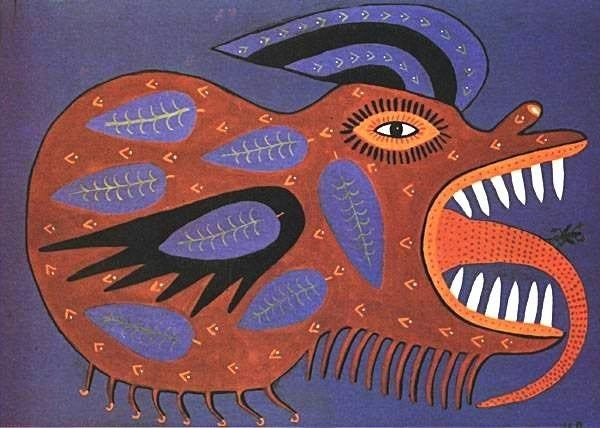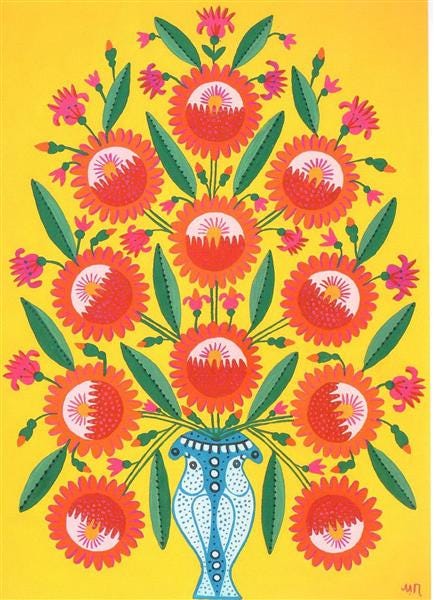If you are new or have landed on Tarantula: Authors and Art for the very first time, get ready to enjoy a little art history. Our contributor, Karen Grace, an art teacher and historian, will take you for a virtual walk through the pages of history and today’s news. If a friend forwarded you this article, welcome; if you like it, share it or why not subscribe?
As I write this, the Russian invasion and war in Ukraine is 50 days old and sadly it only shows signs of intensifying. Just a few days into the war, on February 28th, amidst the horrific news of explosions in Kharkiv and Ukrainians seeking safety in shelters, I read in the New York Times that the Ivankiv Museum was burning as a result of a Russian attack. It was reported that their collection of 25 works by artist and Ukrainian national treasure Maria Prymachenko were likely destroyed. In the midst of all the carnage and terrible news this might seem like a small thing. “Paintings are just pieces of paper” you might catch yourself thinking but no, they really are so much more.
While I reeled at the thought of such wanton destruction I dug into the works of this artist – to know what might have been lost before it was gone for good. I was spell-bound! Within her work I found fantastical beasts in vivid colors, covered in intricate patterns, staring back at me with strange, almost human eyes. Her colors are cheerful, yet the subjects and scenes seem darker than you’d expect from what otherwise might look like childish innocence. Lions glare and snarl at me, elephants wear funny hats and look about to trample the flowers, bulls wear shoes and mustaches... it is a wild, wild world. Are these paintings of dreams or nightmares? Are they illustrations of stories? I had to know more about the artist behind the work.
Maria Prymachenko was born in 1908 and lived her whole life where she was born, in a little village of Bolodnya near Kyiv. She came from an artistic family and learned embroidery and decorating easter eggs (pysanky) from her mother. A case of childhood polio left her bedridden and she used drawing and embroidery to pass the time. Her talent was noticed in 1936 and she was sent to a workshop in Kyiv where she painted her first series of fantastical beasts in watercolor.
These paintings were so well regarded that they were sent to the Soviet Pavilion of the International Exhibition in Paris in 1937 where they won a gold medal. Chagall said her beasts were like “cousins” to his own and even Picasso loved these “beautiful works of a brilliant woman.” Sadly, war was brewing in Europe, Ukraine was occupied by the Nazis, and both Maria’s husband and brother were killed. This left her to raise her son alone while forced to work on a Soviet collective farm. She stopped painting for many years.
In the sixties Ukraine was experiencing a cultural re-awakening and Maria began painting again. Now she worked in a larger scale, with brighter colors, and she switched to gouache paints. (These are like watercolors but thicker, not transparent.) She loved her work and by the number of pieces she created she clearly was always painting! In 1966 she painted the series “For the Joy of People” and it seems that her primary goal was to make people happy with her art:
“I make sunny flowers because I love people; I create for the enjoyment and happiness of people, so that all nations love each other, so that they live like flowers all around the world...”
She shared her work freely – mostly giving her paintings away – and she spent time teaching the children of her village to paint. That year she became an Honored Artist of Ukraine and won the Shevchenko National Prize.
In the 70s she began signing her works and she wrote explanations on the backs of her paintings, connecting her work to world events. Some titles include “May That Nuclear War be Cursed”, “Our Army Our Protectors” and “A Dove has Spread Her Wings and Asks for Peace.” She continued painting until her death in 1997. UNESCO even declared 2009 as the year of Maria Prymachenko, Ukraine’s People’s Artist.
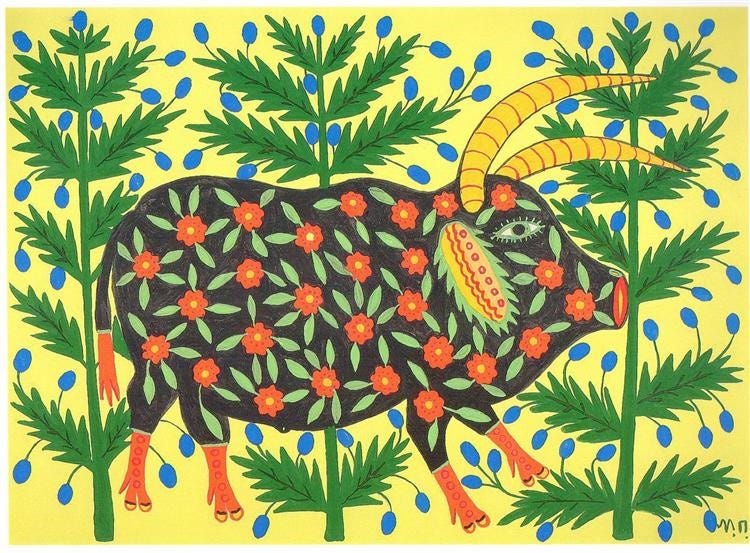
Her work and passion for happiness and humanity has obvious relevance to current events in her beloved homeland. That connection has caused her images to spring back up around the globe as a rallying cry for peace and Ukrainian sovereignty. Her paintings of sunflowers and doves of peace are joyous and hopeful – symbols of a people fighting for their place on earth and in history.
So, the burning of a museum containing her works is not merely some paper and paint gone up in smoke, it is the potential loss of something much greater. It is an attempt to destroy the cultural heritage and spirit of the people of Ukraine. Such destruction of cultural heritage fits the description of not just a war crime but also a “crime against humanity” according to the UN “Report on the intentional destruction of cultural heritage as a violation of human rights” but also potential evidence of an act of genocide.
Amazingly, it seems that not all the works from the Ivankiv Museum were lost, as a man went into the burning building to rescue what he could. The Prymachenko Family Foundation reports that 14 of the paintings there were saved – what a testament to both the power of art and the heart of Ukraine! Of course, the rest of her works could hardly be considered safe at this point, like so much else in the beleaguered country. The majority of her paintings (over 600!) are located at The National Museum of Ukrainian Folk Decorative Art in Kyiv, which has come under renewed attacks in recent days.
If, like me, you would like to learn more about Maria and preserve a little bit of her Ukrainian spirit in yourself, here are some ways to learn more about this artist so dear in the heart of her country.
There are three videos of a Virtual Museum Tour on UATV that tell the story of her life and works Maria Prymachenko, Part 1 | Virtual Museum Tour - YouTube
Learn more about how Maria Prymachenko’s work dovetails with Ukrainian history in this article from the Guardian Cannibalism and genocide: the horrific visions of Ukraine’s best loved artist | Art and design | The Guardian
Here’s an episode of the podcast HerArt where you can listen to to learn a little more HerArt- Maria Prymachenko
And please subscribe to our work here on Tarantula, where this month we are featuring Ukrainian artists
Daria Alyoshkina Art Through Which Light Shines - by Kristina Aleksynaitė (substack.com)
and Iryna Maksymova Tarantula: Authors And Arts Featured Artist of April (substack.com)






